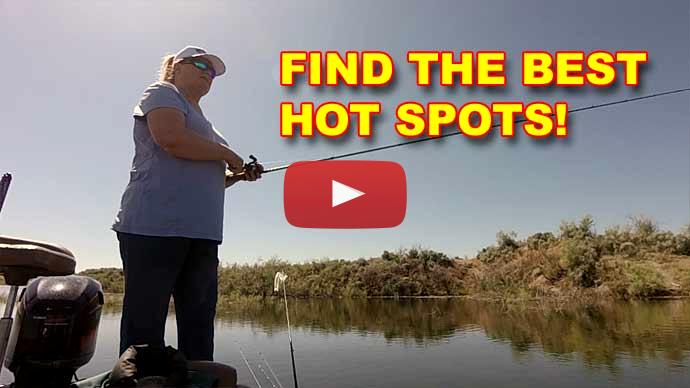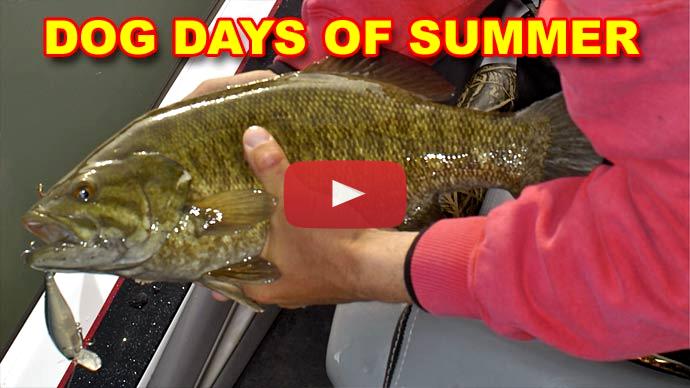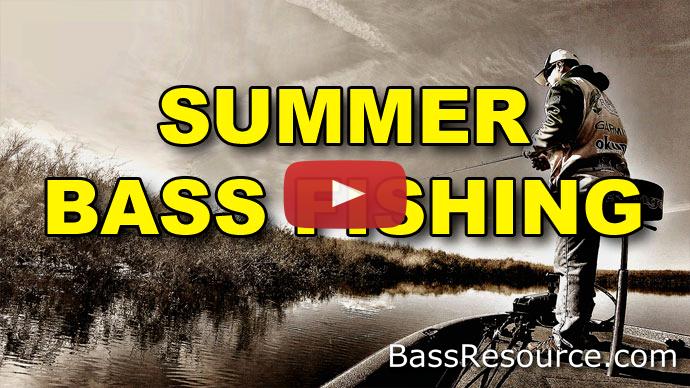Hey, guys. I'm Bassmaster Elite Series pro, Pat Schlapper, with BassResource.com. Today, I wanna talk about offshore structure fishing in the summertime, and it's something that I really like to do. I've spent a lot of time kind of perfecting a few different things to make it a lot...for me to be a lot more efficient when I'm doing that. And the biggest thing before I even get into the baits and techniques and all that is learning how to locate the different types of structure that the fish will use. And a big key is, is spending time behind your electronics, and really getting out there, you know, side imaging, down imaging, looking for likely places that those fish will be. And every lake is a little bit different, you know. It could be rock, it could be a hard spot within a weed bed, it could be an isolated stomp, it could be, you know, a brush pile. Anything like that in the summer is what those fish will generally gravitate to. So, it's not necessarily as easy as, you know, going down the bank and just casting at things you can visually see with your eyes. You gotta find it with your electronics before you even make a cast.
So, what I'll do is if I know where those fish spawn, or I think I know where those fish spawn, I'll kind of start working my way out from the mouth of the cove or, you know, creek arm, whatever it is, and I'll start to look for structure between where that area is towards, say the river channel, or the main basin of the lake, long tapering points, big flats, maybe it's an isolated hump out in the middle. You know, that's the type of areas that those fish like to migrate to and live in the summer. You know, generally deeper water.
So, when I go out and let's say I go and I find a nice rock pile, you know, that I wanna take a cast at, the first bait that I'm gonna pick up 99% of the time is going to be some sort of deep diving crankbait. This happens to be a Rapala DT6. You know, and that Rapala lineup, they go anywhere from a DT4 all the way to a DT20. So, depending upon the depth is what, you know, which one you will pick up. And I like a crankbait because I can make a long cast, I can cover that area real effectively, and I can pick off any active fish. And a lot of times if there's a group of fish there, you'll catch some on a crankbait. So, I'll go through there, catch what I can catch on that, maybe try different colors, you know, couple of different colors, couple of different types of crankbaits to, you know, see which one they're biting better.
For the setup on a crankbait, it varies a lot depending upon which one you're throwing. This particular rod is a St. Croix Mojo Big cranker. This is really good for, you know, a DT10, DT14, maybe a Strike King 5XD, you know, kind of that mid-size crankbait. You could throw six on it would be all right, but more like a DT10 or DT14. I'll throw 12 to 14-pound Sunline FC Sniper, a 6:3 to a 7:1 gear ratio reel, depending upon, you know, how big the crankbait is. If it's real big crankbait, I like to go a little lower gear ratio. But that's what I'm gonna start with as a crankbait.
So, once I go through there, I get a few on a crankbait, or maybe I don't get any in a crankbait, but I feel like there still should be fish there. Then I'll pick up something and I'll drag it. A lot of times I'll go to a Magnum trick worm. You know, this is a straight tail worm. This is a Big Bite, 8-inch finesse worm. I've got it on a half-ounce Big Bite head, you know, something I can cast a long ways, keep bottom contact with. And there's something about a big worm in the summer with bass on structure. It, for whatever reason, they just...it works. It really shines in the summer. And the Magnum Shakey Head is kind of overlooked a lot of times. It's not real flashy. You know, there's really not a lot of action in the tail, but it just bangs along the bottom and, you know, it'll stand up nice on that big bitehead. And it gets big bites.
So, on that, I'll throw that on a 7’ 4” heavy power St. Croix Victory fast action. And I'll run anywhere from 16 to 20-pound Sunline Shooter Fluorocarbon, depending upon, you know, how thick the cover is, how deep it is, you know, kind of your standard variables.
But that's the general setup. I want something pretty beefy with that because a lot of times when I'm out fishing, you know, that deeper structure, I'm making a long cast. So, if I get a bite at the end of the cast, I need a lot of power to bury that hook. And when you hook one with it, I mean, you just winch them. You don't let them get any, you don't want them to turn. So, you want something, you want a stout rod. So, kind of interchangeable with that Magnum shakey worm is just gonna be, you know, your ribbon tail. So, this is a Big Bite B2. You know, it's a plum color, kind of a, you know, a staple. And I'll throw that on. Actually, it's the same rod, but it's a Legend Xtreme. So, 7’ 4” heavy power, fast action. This I'll usually run 18 or 20-pound Sunline Shooter Fluorocarbon. And if I'm around brush, I prefer to throw this around. You know, if it's a brush pile offshore, I prefer to throw the Texas rig more than the Magnum Shakey. I just think it comes through a little bit better. And the other key thing is don't peg your sinker. You know, I think it's become real commonplace for people to just peg their sinker no matter what. And that's fine if you're up pitching around cover or whatever. But when you're out offshore fishing, I really think that you get more bites without that sinker pegged, especially pulling over structure like brush or a log, you know, isolated grass clumps because when you pull that bait over, and it comes over the top, that sinker will separate and will fall in front of it, and that worm will end up falling almost, you know, it's like it's free-floating, and it'll just kind of hang and go down. And that's a lot of times when you'll get your bites. So, once again, kind of interchangeable with that Magnum Shakey Head, but just I'll always have a 10-inch ribbon tail out and a Magnum Shakey Head and just kind of interchange those things.
The next thing that I'll throw that's absolutely, you know, it's one of my favorites is it's a Carolina rig. So, this is probably the third cycle that I'll go through. And it's, you know, I have a Big Bite Quarantine Craw on it right now, which is a little bit smaller. And you could put a big 10-inch worm on it too. You could put a big craw on it. It's, you know, it's pretty versatile. But this is just a little bit more finesse presentation as far as, you know, when that weight is dragging through, this is kind of back there, kind of free-floating around. I think that you'll trigger some less aggressive fish with that Carolina rig, and keep bottom contact with it. Just drag it through whatever structure there is, and you'll definitely pick up some extra fish if you're there.
When I'm running a half-ounce weight, which a lot of times when I'm structure fishing, depending upon the depth, if I'm past 12 foot, I'll usually go to a 3/4-ounce. With a half-ounce, I'm gonna use a 7’ 3” medium-heavy Saint Croix Victory fast action, something with good length, good parabolic bend, plenty of power to fight the fish. When I go to that, like I said, that 3/4, I'll go to a 7’ 4” heavy just because that sinker is heavier, and I wanna be able to have the power, you know, to pick that sinker up when I set the hook. So, once I get through all those baits, and this is where I think a lot of people, especially people new to structure fishing, where they'll kind of, "All right. I've caught them all. I've gone through those baits, there's nothing left." What you always wanna pick up is a drop shot. And I know it's probably not something you would necessarily think about doing that but you will catch extra fish on it. And honestly, a lot of times you're gonna catch a lot of the bigger fish on this.
You know, after you've caught whatever, 10 fish out of there, they stop biting. This is just a little Big Bite Scentsation Cliff Hanger drop shot worm. And I've got a 1/4-ounce on there now. Once again, it'll depend on the depth and how windy it is. And then I've got a 2/0 ReBarb drop shot hook on there. And I'll use the St. Croix Legend Tournament. It's actually their drop shot rod. It's a 6’ 10” medium-light extra fast. And then I'll use a 10-pound Sunline SX1 braid and an 8-pound FC Sniper Fluorocarbon leader. I think it's really important that you don't wanna...you wanna keep this real finesse. You know, even if you're dealing with bigger fish, don't try to put a real heavy leader on there because this is what you're cleaning up that spot with. This is what you're looking for those extra bites that you might miss if you don't throw it. So, that's kind of the rundown on how I would tackle summer offshore structure fishing.



